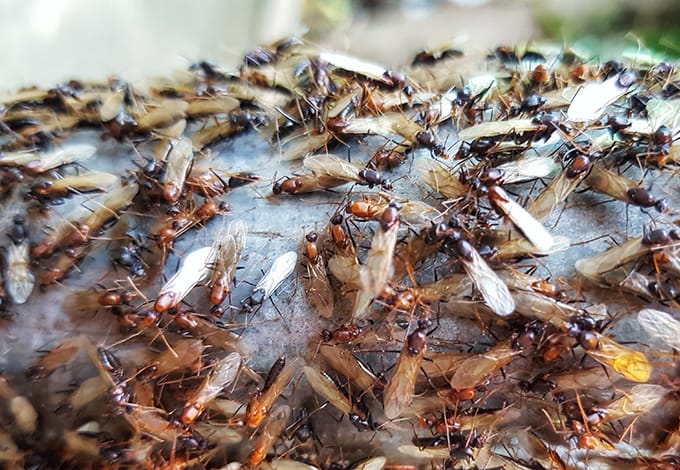

What It Means If You See Termite Swarmers Around Your Long Island Property
Do you know what a swarmer is? It is a type of termite. In a termite colony, there are different termites with different roles to play. The queen produces offspring and helps her colony grow. The king does his part with the reproductive process and also helps to raise the new termites. There are no dead-beat dads in a termite colony. But the dads aren't the providers in this family. Workers take on that role. Worker termites are the only termites that eat. The rest of the termites in the colony get their food from the workers through a process called trophallaxis. As termite workers eat, they are protected by soldier termites. These termites have big orange heads and black pincers that help them fight predators. Last, we have the swarmers. Here's what you should know about them and what it means when you see swarmers around your Long Island property.

What Is A Swarmer Termite?
When a termite nest matures, the queen begins to develop swarmers. These are male and female reproductives that have one job: leave the nest and establish new nests. When they leave their nests, you might see them if you know what you're looking for.
What Does A Swarmer Termite Look Like?
Swarmers are black with long white wings that are rounded at the tips. These wings are the most noticeable visual characteristic of a swarmer and will help you recognize these termites from a distance. They go from the thorax all the way down past the tip of the abdomen. Some species have an overlap that is as long as the length of the entire body. But while these wings are noticeable, swarmers aren't. The entire length of a termite swarmer from head to wing tips is only about ½ to ⅝ of an inch in length for many termite species. That's pretty small. So you might not even realize you're looking at a termite swarmer when it lands on your skin and flies away.
What Does It Mean When You See Swarmers?
If you see these tiny insects crawling around on the outside of your Long Island property, two things are likely to be true. There is a nest on your property, or there is a nest near your property. This is because termite swarms don't travel very far, and swarms only last about 30 minutes. Second, the termite nest is mature. That means you've had worker termites on or near your property for more than a few years. Since worker termites can travel as far as the length of a football field to find food sources, your home may already have termite damage.
When Will I See Termite Swarmers?
Swarms typically happen in the spring. The conditions in spring inspire the release of these male and female winged reproductives. It is important to keep an eye out for them and to take steps to reduce conditions that attract them to your property. If termites are not already in the ground on your property, swarmers can begin a nest in your yard. Here are two things they're looking for:
- While termite swarmers don't eat, their babies do. Therefore, they are looking for sources of decaying wood. Removing these sources can help you resist an infestation. Some wood that termites eat are logs, stumps, firewood, old fences, old decks, and the trim around flower beds.
- Termite workers require moisture to survive. Queens and kings know this. Therefore, they will establish nests in areas of high moisture. Controlling moisture can help to stop an infestation. A few helpful ways to control the moisture that attracts swarmers are cleaning out obstructed gutters, trimming tree branches to allow sunlight to dry densely shaded areas, putting spacing between plants in landscaping to allow airflow, and repair leaky exterior water spigots.
Termite Control
Long before termite swarmers come onto your property, you should look into termite protection for your Long Island home. These are destructive insects that can put your equity at risk. Reach out to Parkway Pest Service and let our team help you safeguard your home or business investment from termite damage.
Customer Testimonials
-
Excellent, prompt, and courteous service. The technician arrived on time and took care of our yellowjacket nest and carpenter bee problems. Highly recommend Parkway if you have pest issues.- Jeff R.
-
Professional, knowledgeable, and great service. The technicians are always on time and the pest issues are solved within a couple of days. Highly recommend Parkway Pest Services for any pest problem. Thank you!- Jean R.
-
Parkway Pest Services responded very quickly to our request to have a tech come and inspect our rodent issue. They provided excellent service, outlining steps they would take as well as the steps we should take. Our pest situation has been resolved! I highly recommend them!- Robert M.
-
“Beyond friendly and professionally she really understood how freaked out we were and felt like she was in it with us the whole way.”- Emily W.
-
“The gentlemen that came over was very friendly and honest!”- Patty M.
-
“They sent a tech the same day and truly saved the day for my Aunt’s home in New York.”- D. Hunsaker
-
“I called Parkway, got Shoshanah on the phone, told her about the problem (she could tell I was a wreck!) Within an hour Steve was here!”- C. Petronella
-
“Had some scheduling issues and with her kindness patience and professionalism sorted it all out!”- John D.


Our Blog & News
Catch up with the latest blog articles from Parkway or see news that is happening in the pest control industry.







